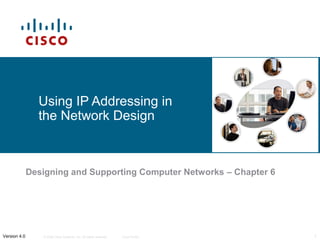More Related Content
Similar to CCNA Discovery 4 - Chapter 6
Similar to CCNA Discovery 4 - Chapter 6 (20)
More from Irsandi Hasan (20)
CCNA Discovery 4 - Chapter 6
- 1. Using IP Addressing in
the Network Design
Designing and Supporting Computer Networks – Chapter 6
Version 4.0 © 2006 Cisco Systems, Inc. All rights reserved. Cisco Public 1
- 2. Objectives
Describe the use of a hierarchical routing and
addressing scheme
Create the IP address and naming scheme to support
growth and efficient routing protocol operation
Describe IPv6 implementations and IPv6 to IPv4
interactions
Implement IPv6 on a Cisco device
© 2006 Cisco Systems, Inc. All rights reserved. Cisco Public 2
- 3. Describe the Use of a Hierarchical
Routing and Addressing Scheme
Functions of a hierarchical addressing scheme:
Prevent duplication of addresses
Control access, monitor security and performance
Support modular design and scalability
© 2006 Cisco Systems, Inc. All rights reserved. Cisco Public 3
- 4. Describe the Use of a Hierarchical
Routing and Addressing Scheme
Poorly-planned IP addressing can result in
discontiguous subnets
Routing protocols may display more than one summary
route to discontiguous subnets
Manual configuration of routing protocols may be
required
© 2006 Cisco Systems, Inc. All rights reserved. Cisco Public 4
- 5. Describe the Use of a Hierarchical
Routing and Addressing Scheme
VLSM provides more efficient use of IP address space
VLSM enables routers to summarize routes on
classless boundaries
© 2006 Cisco Systems, Inc. All rights reserved. Cisco Public 5
- 6. Describe the Use of a Hierarchical
Routing and Addressing Scheme
CIDR ignores classful boundaries
CIDR enables supernets: VLSMs with shorter prefix
lengths than the defaults
• Summarization produces leaner routing tables
© 2006 Cisco Systems, Inc. All rights reserved. Cisco Public 6
- 7. Create the IP Address and Naming
Scheme
Plan the entire
addressing scheme in
advance
Allow for significant
growth
Support the physical
layout, routing, and
security
© 2006 Cisco Systems, Inc. All rights reserved. Cisco Public 7
- 8. Create the IP Address and Naming
Scheme
Define the addressing blocks scheme to support
summarization
Document locations, VLAN or network type, and
number of hosts and networks
© 2006 Cisco Systems, Inc. All rights reserved. Cisco Public 8
- 9. Create the IP Address and Naming
Scheme
Select the
appropriate routing
protocol to use in the
network
Support classless
routing and VLSM
Small and infrequent
updates to reduce
traffic
Fast convergence
© 2006 Cisco Systems, Inc. All rights reserved. Cisco Public 9
- 10. Create the IP Address and Naming
Scheme
Factors in designing the routing strategy:
Load balancing
Authentication
© 2006 Cisco Systems, Inc. All rights reserved. Cisco Public 10
- 11. Create the IP Address and Naming
Scheme
Determine when and how to summarize address space
for efficient routing
© 2006 Cisco Systems, Inc. All rights reserved. Cisco Public 11
- 12. Create the IP Address and Naming
Scheme
Design an address scheme for an internetwork and
assign ranges for hosts, network devices, and the
router interface
© 2006 Cisco Systems, Inc. All rights reserved. Cisco Public 12
- 13. Create the IP Address and Naming
Scheme
Determine an appropriate naming scheme
Use codes and avoid names that easily identify
protected resources
Maintain consistency
Document the names
© 2006 Cisco Systems, Inc. All rights reserved. Cisco Public 13
- 14. Describe IPv6 Implementations and IPv6
to IPv4 Interactions
Enhancements available with IPv6:
Mobility and security
Simpler header
Address formatting
© 2006 Cisco Systems, Inc. All rights reserved. Cisco Public 14
- 15. Describe IPv6 Implementations and IPv6
to IPv4 Interactions
Common transition
methods from IPv4 to
IPv6:
Dual stack
Tunneling
Proxying and
translation
© 2006 Cisco Systems, Inc. All rights reserved. Cisco Public 15
- 16. Describe IPv6 Implementations and IPv6
to IPv4 Interactions
How to configure IPv6 on a Cisco device:
Activate IPv6 forwarding
Configure interfaces
Configure name resolution
© 2006 Cisco Systems, Inc. All rights reserved. Cisco Public 16
- 17. Describe IPv6 Implementations and IPv6
to IPv4 Interactions
RIPng for IPv6:
The tag parameter in
interface configuration
mode
The ipv6 rip name enable
command on directly-
connected routers
© 2006 Cisco Systems, Inc. All rights reserved. Cisco Public 17
- 18. Summary
Allocation of IP addresses must be planned and
documented.
A properly-designed hierarchical IP addressing scheme
makes it easier to perform route summarization.
A complex hierarchy of variable-sized networks can be
summarized at various points using a prefix address.
The choice of routing protocol must support the VLSM
and summarization strategy.
A good network naming scheme makes the network
easier to manage and easier to navigate.
IPv6 addresses are written as a series of eight 16-bit
hexadecimal digits separated by colons.
© 2006 Cisco Systems, Inc. All rights reserved. Cisco Public 18
- 19. © 2006 Cisco Systems, Inc. All rights reserved. Cisco Public 19

